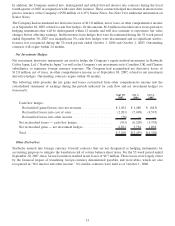Starbucks 2007 Annual Report Download - page 65
Download and view the complete annual report
Please find page 65 of the 2007 Starbucks annual report below. You can navigate through the pages in the report by either clicking on the pages listed below, or by using the keyword search tool below to find specific information within the annual report.
The expected term of the options represents the estimated period of time until exercise and is based on historical
experience of similar awards, giving consideration to the contractual terms, vesting schedules and expectations of
future employee behavior. For fiscal years 2007 and 2006, expected stock price volatility is based on a combination
of historical volatility of the Company’s stock and the one-year implied volatility of its traded options, for the
related vesting periods. Prior to the adoption of SFAS 123R, expected stock price volatility was estimated using
only historical volatility. The risk-free interest rate is based on the implied yield available on U.S. Treasury zero-
coupon issues with an equivalent remaining term. The Company has not paid dividends in the past and does not plan
to pay any dividends in the near future.
The BSM option valuation model was developed for use in estimating the fair value of traded options, which have
no vesting restrictions and are fully transferable. In addition, option valuation models require the input of subjective
assumptions, particularly for the expected term and expected stock price volatility. The Company’s employee stock
options have characteristics significantly different from those of traded options, and changes in the subjective input
assumptions can materially affect the fair value estimate. Because Company stock options do not trade on a
secondary exchange, employees do not derive a benefit from holding stock options unless there is an increase, above
the grant price, in the market price of the Company’s stock. Such an increase in stock price would benefit all
shareholders commensurately.
The following summarizes all stock option transactions from October 3, 2004, through September 30, 2007:
Shares
Subject to
Options
Weighted
Average
Exercise
Price
per Share
Weighted
Average
Remaining
Contractual
Life (Years)
Aggregate
Intrinsic
Value
(In thousands)
Outstanding, October 3, 2004 ................... 76,833,220 $ 9.52 6.5 $1,082,324
Granted.................................. 15,627,550 27.17
Exercised . . .............................. (16,169,992) 8.08
Cancelled/forfeited ......................... (3,831,872) 17.86
Outstanding, October 2, 2005 ................... 72,458,906 13.22 6.3 857,319
Granted.................................. 13,357,095 30.52
Exercised . . .............................. (13,222,729) 9.02
Cancelled/forfeited ......................... (3,173,401) 24.51
Outstanding, October 1, 2006 ................... 69,419,871 16.83 6.2 1,196,209
Granted.................................. 12,298,465 36.04
Exercised . . .............................. (12,744,226) 10.23
Cancelled/forfeited ......................... (3,458,007) 30.92
Outstanding, September 30, 2007 ................ 65,516,103 20.97 6.2 507,489
Exercisable, September 30, 2007 ................. 40,438,082 14.65 5.0 488,898
Vested and expected to vest, September 30, 2007 ..... 63,681,867 20.60 6.2 507,489
The aggregate intrinsic value in the table above is the amount by which the market value of the underlying stock
exceeded the exercise price of outstanding options, is before applicable income taxes and represents the amount
optionees would have realized if all in-the-money options had been exercised on the last business day of the period
indicated. As of September 30, 2007, total unrecognized stock-based compensation expense related to nonvested
stock options was approximately $103 million, before income taxes, and is expected to be recognized over a
weighted average period of approximately 24 months. The total intrinsic value of stock options exercised was
$274 million and $327 million during the fiscal year ended September 30, 2007 and October 1, 2006 respectively.
The total fair value of options vested was $28 million and $95 million during fiscal years 2007 and 2006,
respectively.
63
























